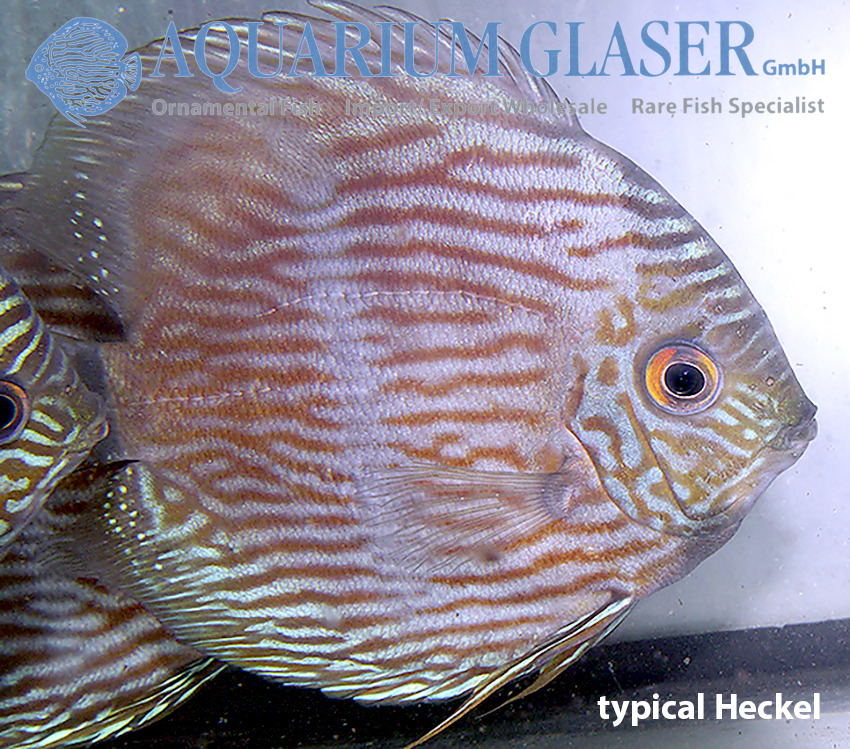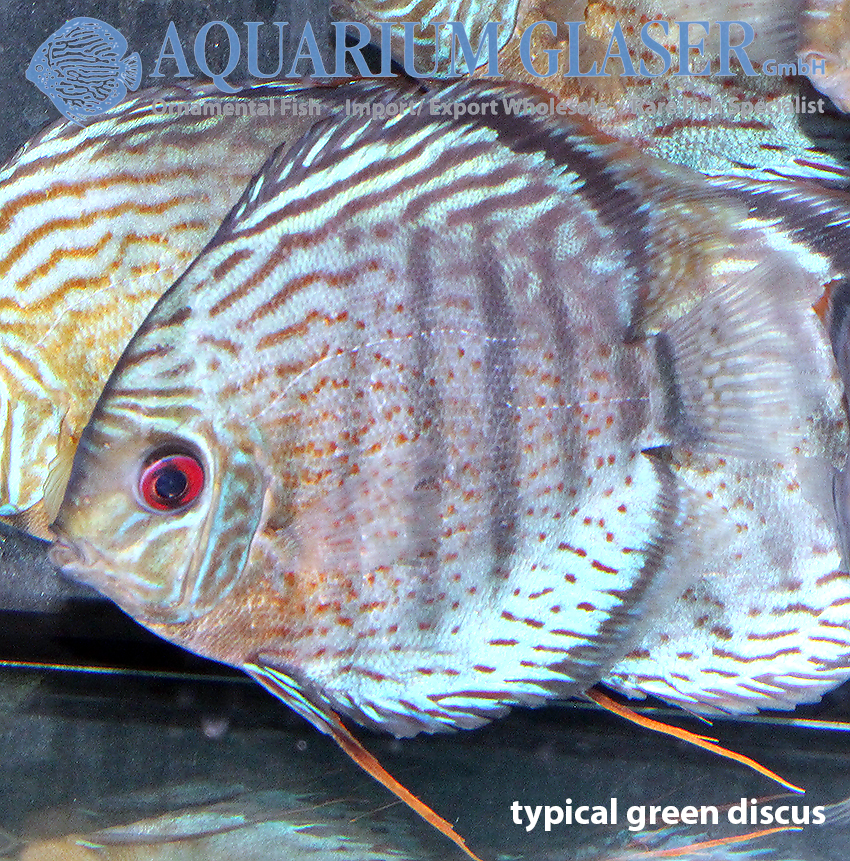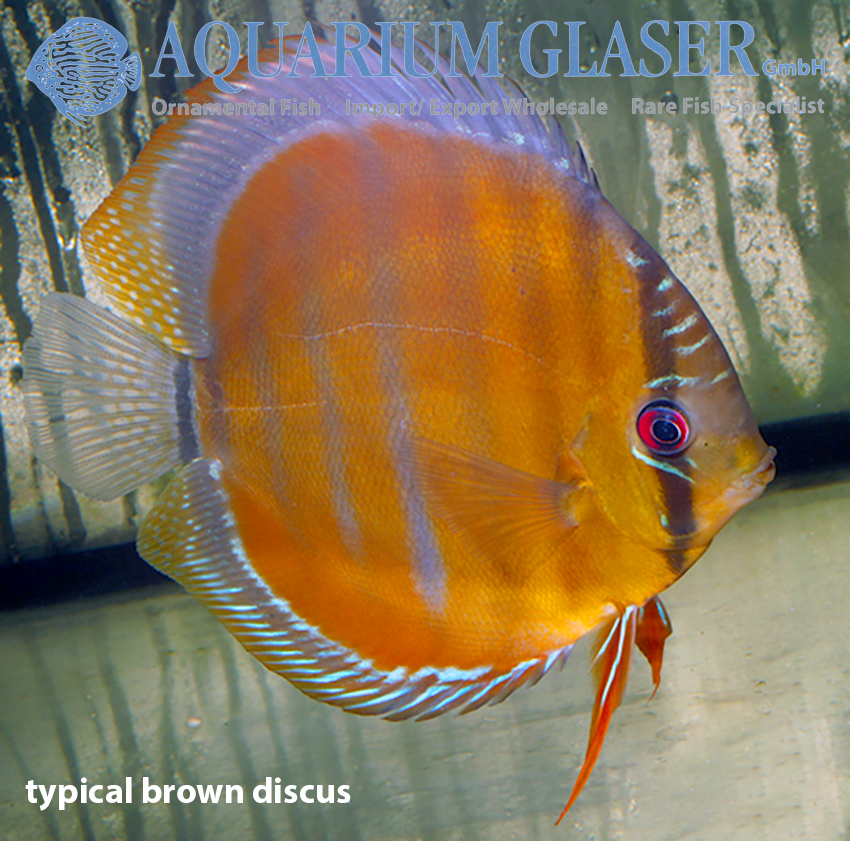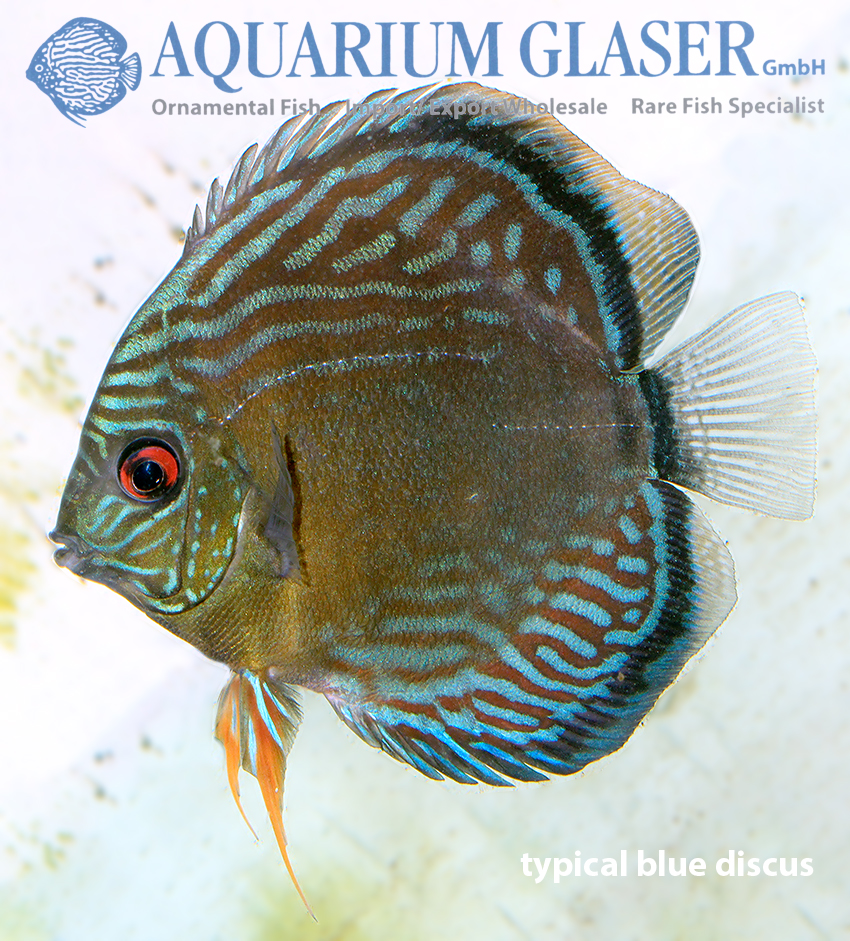The question of which scientific species names should be given to the various discus cichlids is a controversial one. There is agreement that all Symphysodon populations are relatively closely related to each other and that preserved specimens cannot be identified with certainty without color and location; the only exception is the Heckel discus (Symphysodon discus), which sometimes differs from the other discus cichlids in some countable and measurable values.
A distinction is traditionally made between Heckel’s discus (Symphysodon discus), green discus (S. aequifasciatus) and brown/blue discus (S. haraldi) according to color characteristics.
In the past, two subspecies of the brown/blue discus were distinguished, namely the brown discus Symphysodon aequifasciatus axelrodi and the blue discus Symphysodon aequifasciatus haraldi, but then the two were merged, elevated to species status and henceforth called Symphysodon haraldi.




A genetic study of mitochondrial DNA ( = mDNA) by Ready et al. 2006 revealed a picture that does not match the classification into brown/blue and green discus. According to this mDNA study, all blue and green discus (!) west of a natural distribution barrier formed by the Rio Purus represent a species that should be called Symphysodon tarzoo, while all brown and green discus (!) occurring east of the Rio Purus should be called Symphysodon aequifasciatus. According to this view, it is hardly possible to determine the species of brown, blue and green discus without knowing the origin and without DNA examination. If we were to follow Ready et al., we would have to consistently refer to all green, brown and blue discus in the trade as Symphysodon sp. The independence of S. discus is not questioned by Ready et al.
A second study by Bleher et al. 2007, which also worked with mDNA, came to a different conclusion. This study distinguishes three nameable discus species, namely Heckel (S. discus), green (S. aequifasciatus) and brown/blue (S. haraldi). S. tarzoo is therefore a green discus and falls into the synonymy of S. aequifasciatus.
At this point, something needs to be said about DNA tests. Perhaps first of all: DNS and DNA are exactly the same thing, in DNS the “S” stands for “Säure” (acid), in DNA the “A” stands for “Acid”. DNS is therefore the German word, DNA the English one. The chemical substance, the genetic material, is identical (desoxyribonucleic acid).
Many people believe that there is a component of DNA that bears the name of the species, so to speak. This is not the case. Whether an egg cell develops into a chicken, a giraffe or a coconut palm depends on many different DNA components. Since the entire DNA is a comparatively huge molecule, it is not possible (and, by the way, also not useful, but that would take us too far afield here) to compare the total DNA of different species.
Therefore, when examining DNA, only a small piece of the whole molecule is examined and compared with the analogous piece of the species intended for comparison. Since life (at least all higher forms of life) has only evolved once, all existentially important biochemical processes have only been “invented” once and function in the same way in all living beings. It is therefore easy to compare certain proteins in plants and animals, which are essential for respiration, for example. Proteins are coded, i.e. “produced”, by the DNA (or, to be correct, the DNA provides the blueprint for the formation of proteins to the executing cells). If the corresponding DNA section responsible for coding the respiratory protein can be identified, it can be isolated with so-called markers on any DNA. Now you only have a relatively small but very informative section of DNA that can be analyzed with reasonable effort. In the course of evolution, small changes in DNA, known as mutations, occur again and again. Everything indicates that the number of mutations per unit of time is constant. And so, using a marker for the DNA section that codes for a respiratory protein, it is possible to compare the corresponding DNA section of a banana and a chimpanzee. Based on the number of differences found, it is then possible to calculate the time at which the last common ancestor of the banana and chimpanzee lived.
When DNA analyses are used to determine species differences or similarities, the same procedure is followed. If there are many differences, it is very likely that there are two different species; if there are few, then there are not.
The special thing about the mDNA is that it is much smaller and easier to process than the “main DNA”, which is located in the cell nucleus. However, the mDNA exclusively represents the female line, as the mitochondria are not newly formed by the father and mother at fertilization, as is the case with 50% of the DNA in the cell nucleus, but are transferred 1:1 from the mother to the child. The logical consequence: hybrids, i.e. crosses between two species, cannot be recognized when examining the mDNA. If you cross a donkey stallion with a horse mare, the mDNA of the child is 100% identical to the mDNA of a horse and vice versa.
In the case of discus in particular, the examination of mDNA therefore seems unsuitable for clarifying the species question, because in almost all populations in which Heckel and brown/blue discus occur, there are relatively many atypical specimens that are referred to in the trade as “Gypsi” or “Cross”. In terms of their characteristics, they are somewhere between Heckel and brown/blue and are probably either direct hybrids or represent animals in which characteristics from earlier crossbreeding events reappear. The green discus is somewhat isolated in this respect; there appear to be much more effective crossing barriers between green and brown/blue and even more so between green and heckel.
We therefore generally follow the suggestion of Bleher et al. (2007) when naming the fish, because it is very easy to apply in practice and in the vast majority of cases can be harmonized with the external appearance of the fish, but in unclear cases we simply avoid the species name. We are an ornamental fish wholesaler and not a museum. If more recent studies provide convincing, different results, we will certainly follow suit.
When the French scientist Jacques Pellegrin described Symphysodon aequifasciatus in 1904, this description was based on three animals, one from the Santarem area (a brown/blue discus) and two from the Tefe area (green discus). Pellegrin did not notice any color differences in the preserved animals, he considered all three to be the same. In such cases, i.e. when several specimens of equal value within a type series represent different species from the point of view of later workers, one of the specimens must be defined as the actual type, which is henceforth regarded as the reference specimen for the species. This is called a lectotype determination. The scientist who determines the lectotype must select the specimen that comes closest to the verbal description in the original description and justify this. In the case of S. aequifasciatus, however, Pellegrin gave no indication that he somehow distinguished one of his three specimens from the others. When Harald Schultz described the new subspecies axelrodi (brown) and haraldi (blue) in 1960, he did not specify a lectotype for aequifasciatus. Schultz had 104 freshly collected specimens from Lago Tefe for reference, which he considered identical to the aequifasciatus described by Pellegrin. Since then, the green discus has been referred to as aequifasciatus in the literature, as there are only green discus in Lago Tefe.
The literature on discus fishes since 1960 is very extensive and was partly published in hardly known journals and books. It is therefore not known whether a lectotype determination for aequifasciatus took place before 2006. But in their DNA study in 2006, Ready et al. defined the brown/blue discus from Santarem (collection number of the Paris Museum: MNHN 1902-0130) as the lectotype. Thus the name Symphysodon tarzoo, which Lyons coined in 1959 (the imprinted date of the journal is 1960, but it was already printed in 1959 and that is decisive) for green discus from the Leticia area, became the available name for green discus, while the names for brown and blue discus (axelrodi and haraldi) are synonyms of aequifasciatus. The choice of the brown/blue discus as a lectotype for aequifasciatus is extremely unfortunate, as discus fish are among the few species known outside the purely academic world whose scientific names are used very frequently. It would therefore have been in the interests of the stability of zoological naming to choose one of the specimens from Lago Tefe as the lectotype, which would have been possible without further ado. However, unless evidence is provided that a lectotype was already determined by another author with a different specimen of the type series before the lectotype was determined by Ready et al., the valid scientific names are for the Heckel Symphysodon discus, the green S. tarzoo and the brown/blue S. aequifasciatus.
Literature cited:
Bleher, H., K. N. Stölting, W. Salzburger & A. Meyer (2007): Revision of the genus Symphysodon Heckel, 1840 (Teleostei: Perciformes: Cichlidae) based on molecular and morphological characters. aqua, International Journal of Ichthyology v. 12 (no. 4): 133-174
Lyons, E. (1959): Symphysodon discus Tarzoo. New blue discus electrify aquarium world. Tropicals Magazine v. 4 and cover: 6-8, 10
Pellegrin, J. (1904): Contribution à l’étude anatomique, biologique et taxinomique des poissons de la famille des Cichlidés. Mémoires de la Société Zoologique de France v. 16 (nos 2-4): 41-400, Pls. 4-7
Ready, J. S., E. J. G. Ferreira & S. O. Kullander (2006): Discus fishes: mitochondrial DNA evidence for a phylogeographic barrier in the Amazonian genus Symphysodon (Teleostei: Cichlidae). Journal of Fish Biology v. 69 (suppl. B): 200-211
Schultz, L. P. (1960): A review of the pompadour or discus fishes, genus Symphysodon of South America. Tropical Fish Hobbyist v. 8 (no. 10): 5-17
Text & photos: Frank Schäfer




